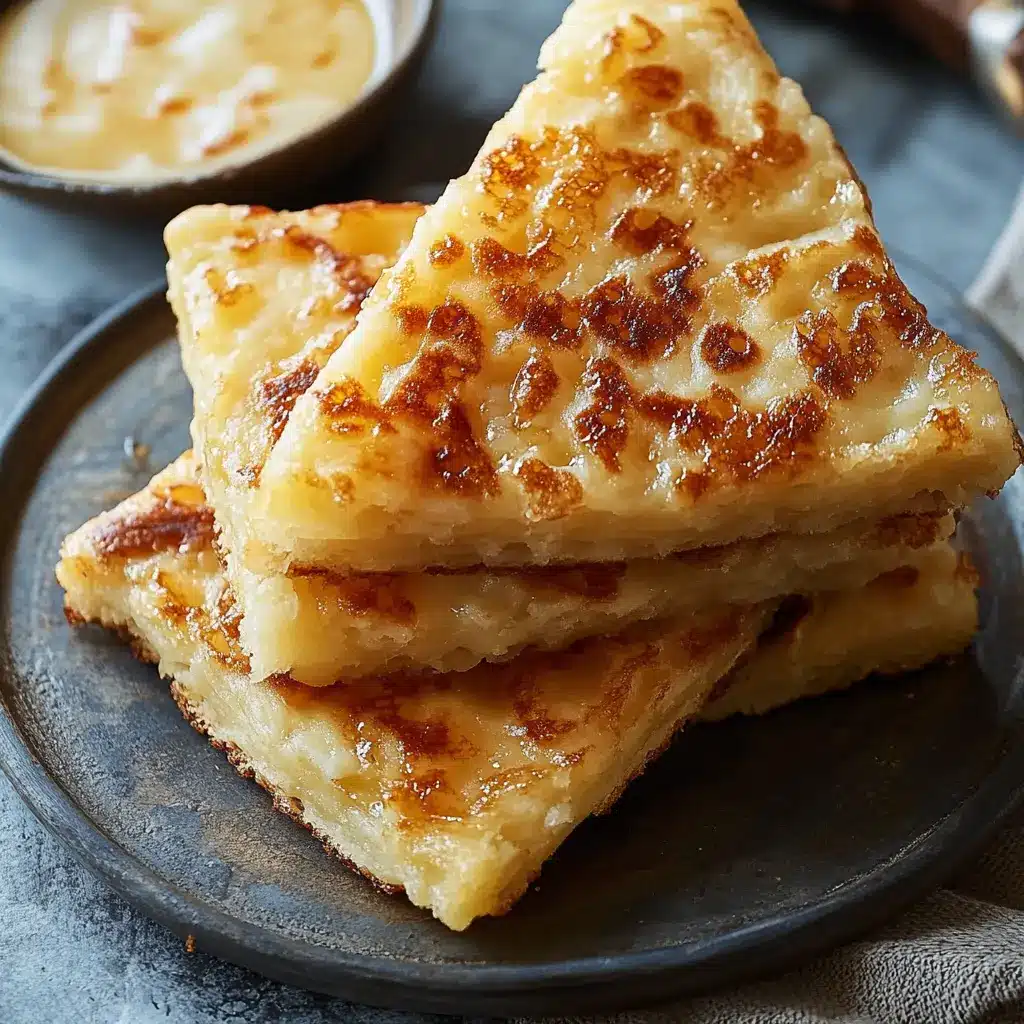Description of this recipe: These potato scones, also known as “tattie scones” in Scotland, are a delightful, savory treat that’s incredibly easy to make. Utilizing leftover mashed potatoes, they transform a simple ingredient into warm, comforting flatbreads perfect for breakfast, brunch, or as a side to any hearty meal.
Why you will love this recipe: You’ll adore this potato scone recipe for its simplicity and versatility. It requires minimal ingredients, most of which you probably already have in your pantry. The recipe is also incredibly forgiving, allowing for slight variations in measurements and techniques. Beyond that, the soft, slightly crispy texture and subtle potato flavor make them incredibly addictive. They are a fantastic way to use up leftover mashed potatoes, preventing food waste and providing a delicious, homemade alternative to store-bought bread. Whether enjoyed slathered in butter, topped with jam, or paired with a full Scottish breakfast, these potato scones are sure to become a family favorite.
Introduction
Potato scones, or tattie scones as they are affectionately known in Scotland, are a staple of the Scottish breakfast table, offering a comforting and satisfying start to the day. While the name might conjure images of sweet, cake-like scones, these are a savory delight, more akin to a flatbread or pancake. Their history is deeply rooted in Scottish culinary tradition, born out of resourceful cooking techniques that made the most of available ingredients.
The beauty of potato scones lies in their simplicity. They are traditionally made with leftover mashed potatoes, flour, butter, and a touch of salt, transforming simple ingredients into something truly special. The baking powder added to this recipe helps create a lighter, more tender scone, while still maintaining that characteristic dense, slightly chewy texture. These are not your fluffy, cloud-like biscuits; potato scones are hearty and substantial, perfect for soaking up the flavors of a full breakfast or serving as a comforting side dish.
What sets these apart from other bread or flatbread options is the subtle potato flavor. It’s not overpowering but adds a unique earthiness that perfectly complements butter, jam, or savory toppings. This recipe is a wonderful way to introduce a touch of Scottish heritage to your home cooking. Whether you have Scottish roots or simply appreciate delicious, easy-to-make food, these potato scones are sure to impress.
Ingredients:
- 2 cups mashed potatoes (cooled): The key ingredient! Make sure they are plain mashed potatoes without added milk or cream for the best texture. Day-old mashed potatoes work exceptionally well, as they tend to be drier.
- 1/2 cup all-purpose flour: All-purpose flour provides the structure for the scones. You may need slightly more or less depending on the moisture content of your mashed potatoes.
- 2 tablespoons butter (melted): The melted butter adds richness and flavor to the dough. You can also use vegetable oil or even bacon grease for a different flavor profile.
- 1/2 teaspoon salt: Salt enhances the flavor of the potatoes and balances the richness of the butter.
- 1/2 teaspoon baking powder: Baking powder provides a little lift, resulting in a slightly lighter and more tender scone.
- Additional flour for rolling: This is essential for preventing the dough from sticking to your work surface.
- Butter or oil for frying: Use butter for a richer flavor or oil for a lighter option. Clarified butter (ghee) is an excellent choice as it has a high smoke point.
Preparation:
Step 1: Prepare the Dough Base In a large mixing bowl, combine the cooled mashed potatoes, melted butter, salt, and baking powder. It’s crucial that the mashed potatoes are cooled. Warm potatoes will make the dough too sticky and difficult to work with. Use a fork or your hands to thoroughly combine these ingredients. Ensure the melted butter is evenly distributed throughout the potatoes. This step sets the foundation for a well-textured and flavorful scone.
Step 2: Gradually Incorporate the Flour Begin adding the flour to the potato mixture gradually, about 1/4 cup at a time. Use a fork or spatula to gently mix the flour in. Avoid overmixing the dough, as this can develop the gluten in the flour, resulting in tough scones. Continue adding flour until a soft, slightly sticky dough forms. The amount of flour needed may vary depending on the moisture content of your mashed potatoes. If the dough is still too sticky, add a little more flour, one tablespoon at a time, until it comes together.
Step 3: Prepare for Rolling Lightly flour a clean, flat work surface. This is essential to prevent the dough from sticking. Turn the dough out onto the floured surface. Gently pat the dough into a round or rectangular shape, about 1 inch thick. You can use a rolling pin or simply flatten the dough with your hands.
Step 4: Roll and Cut the Scones Using a rolling pin, gently roll the dough out to about ¼-inch thickness. Maintain a consistent thickness for even cooking. Now, using a sharp knife or a cookie cutter, cut the dough into desired shapes. Traditional potato scones are often cut into triangles, but you can also use round cookie cutters for a different presentation. Reroll any scraps and cut out more scones. Try not to work the dough too much when rerolling, as this can also lead to tough scones.
Step 5: Cook to Perfection Heat a non-stick skillet or griddle over medium heat. Lightly grease the skillet with butter or oil. You want the pan hot enough to cook the scones evenly but not so hot that they burn. Place the scones in the hot skillet, being careful not to overcrowd the pan. Cook the scones for 2-3 minutes per side, or until they are golden brown and slightly crispy. Flip them carefully using a spatula. If the scones are browning too quickly, reduce the heat slightly.
Step 6: Serve and Enjoy Remove the cooked scones from the skillet and place them on a wire rack to cool slightly. This will help prevent them from becoming soggy. Serve the warm potato scones immediately with your favorite toppings.
COOKING Rating:
- Ease of Preparation: Easy
- Taste: Savory, comforting, and subtly potato-flavored
- Texture: Soft on the inside, slightly crispy on the outside
- Overall: 5/5 Stars
Serving Suggestions:
- Classic Scottish Breakfast: Serve alongside bacon, sausage, eggs, black pudding, and baked beans for a traditional Scottish breakfast.
- Butter and Jam: Simply spread with butter and your favorite jam for a quick and satisfying snack.
- Savory Toppings: Top with cream cheese, smoked salmon, or avocado for a more substantial meal.
- Side Dish: Serve as a side dish with soups, stews, or grilled meats.
- Breakfast Sandwich: Use as a base for breakfast sandwiches with eggs, cheese, and your choice of fillings.
Tips:
- Use Cold or Day-Old Mashed Potatoes: Freshly made mashed potatoes can be too moist. Day-old potatoes are ideal as they’ve had time to dry out slightly.
- Don’t Overmix the Dough: Overmixing will develop the gluten in the flour, leading to tough scones. Mix just until the ingredients are combined.
- Flour Your Surface Generously: This will prevent the dough from sticking and make it easier to roll out.
- Cook Over Medium Heat: Cooking over medium heat will ensure that the scones cook evenly and don’t burn.
- Adjust Flour as Needed: The amount of flour needed may vary depending on the moisture content of your mashed potatoes. Add flour gradually until a soft, slightly sticky dough forms.
- Keep Warm: Store cooked scones in a warm oven until ready to serve.
- Freezing: Cooked scones can be frozen. Cool completely before freezing in a single layer on a baking sheet. Once frozen, transfer to a freezer bag. Reheat in a preheated oven at 350°F (175°C) until warmed through.
Prep Time: 15 minutes
Cook Time: 10 minutes
Total Time: 25 minutes
Nutritional Information: (per scone, approximate)
Calories: 150 kcal Protein: 3g Sodium: 250mg
Conclusion
These potato scones are more than just a recipe; they are a taste of Scottish tradition and a testament to resourceful cooking. With their simple ingredients and easy preparation, they offer a comforting and satisfying treat that can be enjoyed in countless ways. Whether you’re looking for a new breakfast staple, a quick snack, or a unique side dish, these potato scones are sure to become a favorite in your kitchen. So, gather your ingredients, put on some Scottish tunes, and get ready to enjoy the delightful flavors of homemade potato scones.
Q&A About This Recipe:
Q1: Can I use instant mashed potatoes for this recipe?
A: While technically you could use instant mashed potatoes, I strongly recommend against it for the best results. Instant mashed potatoes often contain additives and starches that can alter the texture and flavor of the scones, making them less authentic and potentially gummy. Real, cooked potatoes provide the natural starch and flavor that are crucial for achieving that soft, slightly dense texture that defines a good potato scone. If you absolutely must use instant potatoes, make sure to follow the package instructions closely and use the minimum amount of water necessary to rehydrate them, aiming for a drier consistency. Also, be prepared to adjust the amount of flour in the recipe, as instant potatoes may absorb liquid differently.
Q2: Can I add herbs or cheese to the dough?
A: Absolutely! The base recipe for potato scones is a blank canvas, allowing for endless creative variations. Adding herbs like chives, rosemary, or thyme can elevate the savory flavor profile. Simply chop the herbs finely and mix them into the dough along with the flour. Cheese is another fantastic addition. Grated cheddar, parmesan, or even a touch of crumbled feta can add a salty, cheesy dimension. Incorporate the cheese into the dough during the flour addition. Be mindful that adding extra ingredients may slightly alter the texture, so you may need to adjust the amount of flour accordingly.
Q3: Can I cook these on a cast-iron skillet?
A: Yes, a cast-iron skillet is an excellent choice for cooking potato scones! Cast iron retains heat exceptionally well, ensuring even cooking and a beautifully golden-brown crust. Before cooking, make sure your cast-iron skillet is properly seasoned. Heat the skillet over medium heat until it’s hot but not smoking. Lightly grease the surface with butter, oil, or even bacon grease for added flavor. Cook the scones as directed in the recipe, flipping them carefully when they are golden brown on the bottom. The cast-iron skillet will impart a slightly crispy texture to the scones, making them even more delicious.
Q4: How do I prevent the dough from sticking to the rolling pin?
A: Preventing the dough from sticking is key to a smooth rolling process. The most important thing is to ensure your work surface and rolling pin are well-floured. Sprinkle a generous amount of flour on both the surface and the rolling pin before you start rolling. You can also lightly flour the top of the dough. If the dough starts to stick mid-roll, gently lift it, sprinkle more flour underneath, and re-flour the rolling pin. Another tip is to work quickly and efficiently. The longer the dough sits on the surface, the more likely it is to stick. You can also use a silicone rolling mat, which is naturally non-stick.
Q5: Can I bake these instead of frying them?
A: While traditionally potato scones are cooked on a griddle or skillet, you can bake them for a slightly different texture. Preheat your oven to 400°F (200°C). Place the cut scones on a baking sheet lined with parchment paper. Brush the tops with melted butter or milk for a golden-brown finish. Bake for 15-20 minutes, or until the scones are golden brown and cooked through. Baked potato scones will be less crispy and slightly drier than fried ones, but they are still a delicious and healthier alternative. The baking time may vary depending on your oven, so keep a close eye on them.

